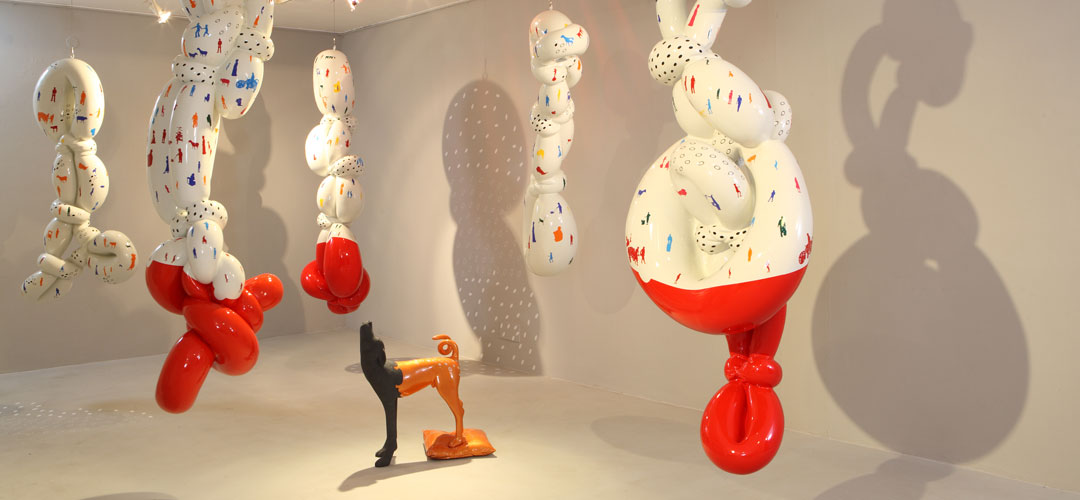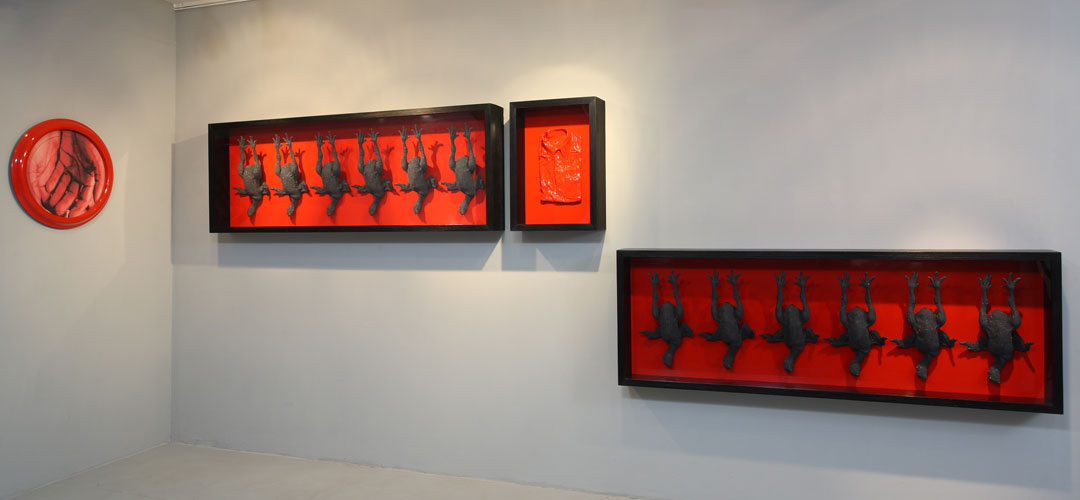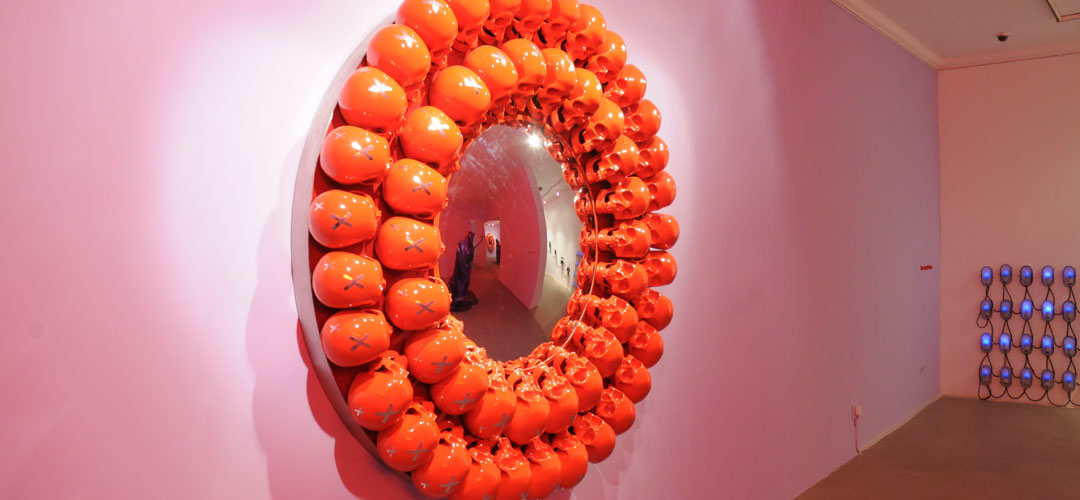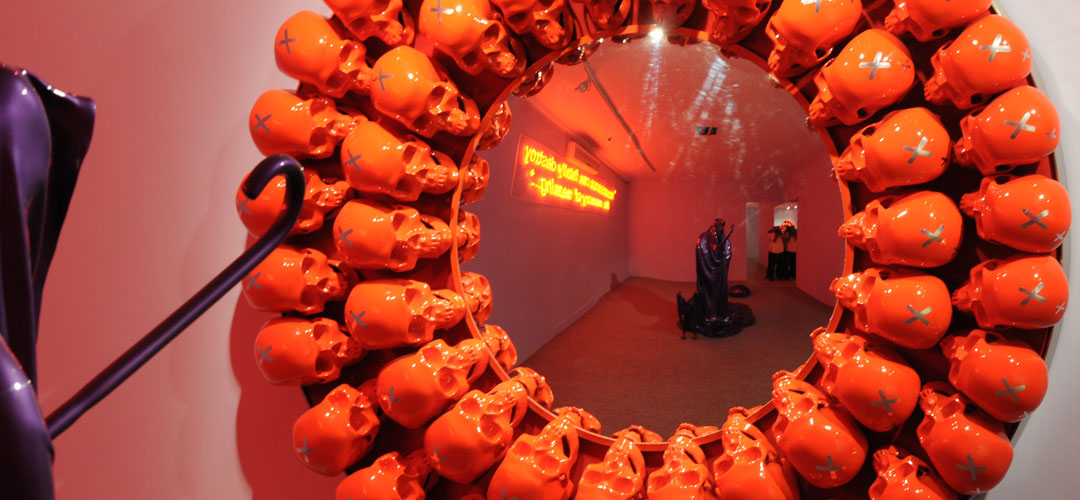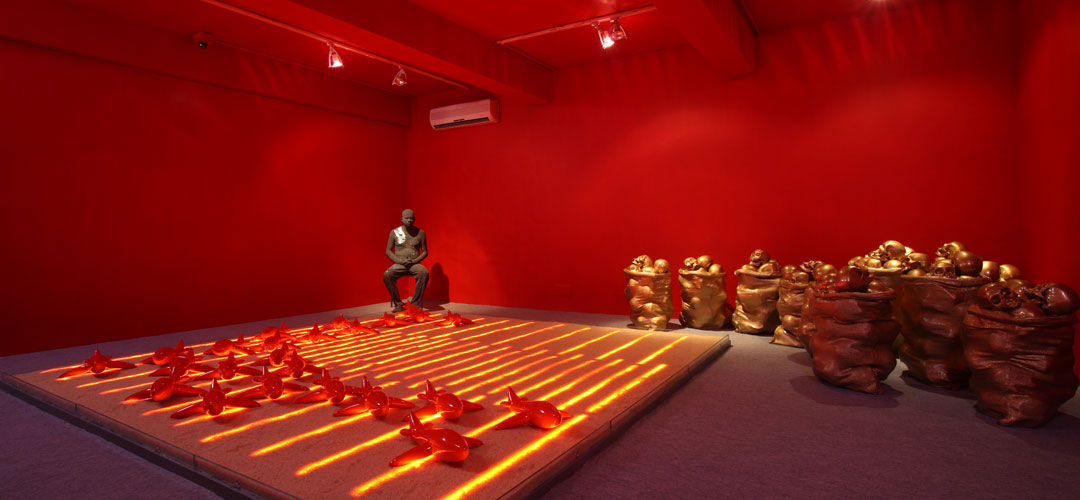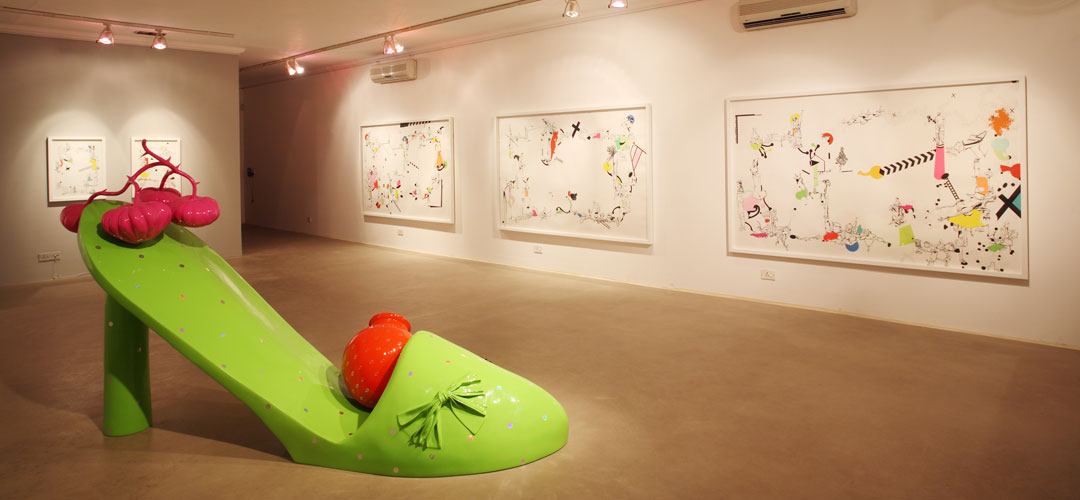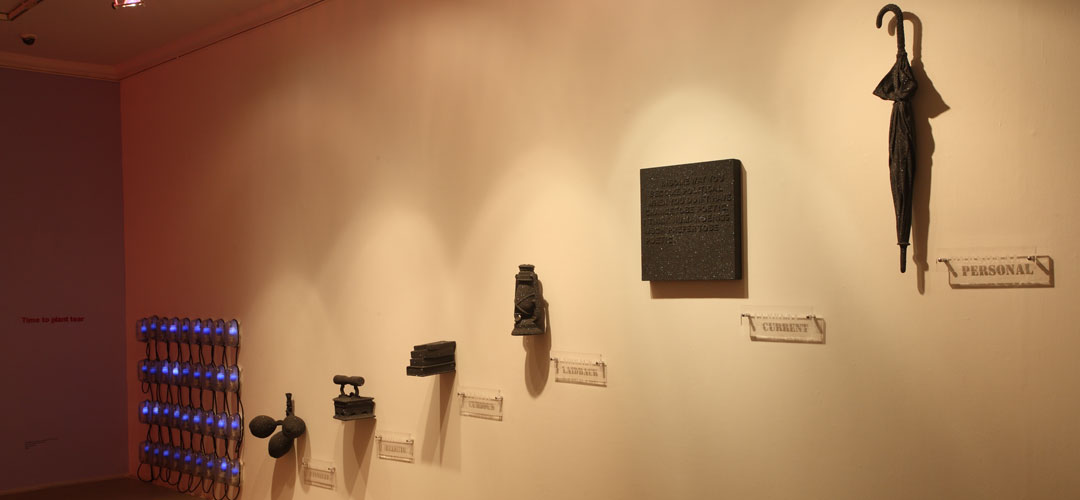Description
About the works of George martin P.J.
Readings of contemporary expressions through a few historical and formal accounts.
‘Every thing suggests that there exists a certain point of the mind at which life and death, the real and the imaginary, the past and the future, the communicable and the incommunicable, the heights and the depths, cease to be perceived contradictorily. Now it is vain that one would seek any other motive for surrealist activity than the hope of determining this point’.
– André Breton
George Martin PJ has come up with his recent most body of works, collectively naming them as Objective Voice. The title as it registers has to be deciphered through most extensive of its significations; since the compendium of works in an unfeigned sense are representations of the ‘real’ but deceptively spontaneous to an extent where the surface readily provides a ground to read them as surreal. To begin with, reading the work which is called Objective Voice visually may appear as excerpts from Pop-art fluxed with reflection of current sensibilities. However of contemporary times and particularly for many young Indian artists scanning back into historical references is a frequent and reckonable tendency. George Martin too, readily refers back into the visual repertoire of imageries belonging to the large and wide art historical archive and to that of his private journal of incidences and opinions.
The text will be ambitious to read into the textual and formal material that is used in each work to relate it to the tendencies that some 20th century artists leaned towards during the artistic movements of Dadaism or Surrealism. This is because regardless of our abnegation they are still cultural and referral harbingers for present day art professionals in more than one way.
However some these references for Martin are not compulsive instruments, they probably come up as expressions of natural affinity. The exhibition which is also named after one of his works is designed to vehicle a series of drawings on paper, titled as Inlaid Anecdotes and six installations using multiple mediums.
The Inlaid Anecdotes series are a collective of drawings in acrylic and water proof ink on acid free paper. Each piece of drawing appears like an alphabet which would further help one to decode rest of the text within the body of works that Martin has created this time. The drawings are surrealistic in content, the arrangement of images on rectangular papers almost following the edges of the paper / ground to make the chain of compositions roll into broken narratives.
Parts of the drawing reminds impulsively of Max Ernst’ images like the one, Airplane- Swallowing Gardens. The black and white drawings punctuated by bright red, yellow and blue patches redefine the uniqueness of each image and controls each from colliding and dismantling by the other. They are like automated dream sequences where part is light and part darkness, a little is rational while a lot is ambiguous and the lines between real and imaginary is constantly blurring.
Crude Sanctum
Objects used for the work are; a red neon reading ‘No nonsense can fatally destroy the memory of meaning’ , a convex mirror and fiber cast skulls in red. Fiber cast replica of the Joseph Beuy’s performative figure in violet form a prime locus within the work. The figure which is a frozen form, a facsimile of the Joseph Beuys performance ‘I like America and America likes me’ denote a politically conscious stance, by the artist. There is a dog at the feet of the cloaked figure, which is indeed a domesticated replacement of the original wild coyote included within the performance by Beuys, who during his life time was a highly controversial figure; today is regarded as one of the most influential artistic personalities of the 20th century and have channelised the course of representation in art to a new direction altogether.
The colour violet and cloaked form of the standing figure is apparitional; again using automobile finish in the work further strengthens an artistic stance of adoring irrationality against pseudo-progression in culture. This exercise is something that Martin has been performing for some time now, where non-art mediums are used for artistic purposes. The term ‘sanctum’ carries a definite set of meanings to different cultural beliefs; in this case Martin uses the title to further enhance the impact of the visual materials in the work by imposing an ironic usage of sacredness that is associated with iconic images in art.
Red neon reads the phrase ‘No nonsense can fatally destroy the memory of meaning…’ within the space of the installation, has a similitude to automation of subtextual messages inlaid in the work. The employment of convex reflective mirror along with red colour plaster cast skulls create a surreal frame for the later; making it look nonsensical at the surface but sniping beneath.
Time to plant Tear is an interesting work which reads like collage of small sculptural forms fixed on the wall. The sculptural forms are objects, specific to a certain time, beliefs and region, like green coconuts, one primitive type of iron, books, hurricane lantern, a plaque which reads ‘In some way you became political; when you don’t have chance to be poetic. I think human beings would much prefer to be poetic,’ and which suggests a positively imaginative and romantic tendency of the artist to seek refuge in words when images alone do not help; and finally an old fashioned umbrella at the end of the series speaks of retentions. Each of these objects are further substantiated with stray yet meaningful words to the context of the work such as Laidback, Eclectic, Curious, Current, Personal are placed in that order from bottom to top, all done in acrylic sheets. Where each word when related with the respective image are capable of generating a chain of sequential emotions. The blue light series are placed along with the work at extreme right, would axiomatically heighten the curiosity of the viewer about the realizations that the artist has reached. Here in this work the objects are amiably sentimental unlike the incisive soup cans of Warhole or urinal ‘Fountain’ of Duchamp.
All the replicas of the objects used in the installation are signifiers of a social time and class which were real to the urban space not very long ago, like the hurricane lantern was a common household object in the post electricity but pre electrical converter facilitated Indian urban middle class space, which in the present context is more readily seen used by the economically challenged class in the cities and largely used in many rural households where distribution of power is still at a regrettable stage. Similarly the other objects in the work too, enable one to wind back and recall each ones social significance.
Forgone conclusion/ Laugh & Re-Memorization; the work is installed with in red walls and consists of a sculpture/figure portraying the artist’s self image. The figure is seated and on its body there are patches sporadically painted with automobile paint. The square space in the ground resembles a condensed yet contradictory sight-scape of urban aggression over eternal agrestic values and culture. It consists of red inflated air crafts representing a ‘game’ of overmastering that was played and is still being played between different ideologies and ethics. This space is divided by horizontal setting of neon lights and depicts rice fields. Skulls, like in another work in this exhibition appear in this work too, but all piled and stuffed in sacks instead of a coherent arrangement. The sacks catastrophically angle up a corner of the conjured rice field. The self image of the artist in the work is seated on a stool and over looks the chronicle; that is the rice field, the air planes and the skulls. Numerous fibre casts of skulls signify an aftermath of a mayhem/war and are acutely allegorical in nature. They remind of locutions that the skulls of the holocaust victims were used by Nazi officers as paper weights during the Third Reich although this definitely is not the sole historical reminder of atrocity, since the same can be recalled in numerous ways, layers and phases to make present human race ‘civilized’. The generous use of red all over the walls, the red air planes all convincingly create a museum-ised war scene. Fiberglass, silicon, automotive colours, rice, neon lights, wood, glass, steel are some of the materials used in the work should be closely thought about , because as we know they are utilitarian objects to a non-artist entity.
“As regards art, it is well known that some of its peaks by no means correspond to the general development of society; nor do they therefore to the material substructure, the skeleton as it were of its organization.” , like Karl Marx said art is often a perceptible expression and that the relation of art to the development of the productive forces is not simple and direct, but dialectical and contradictory. This work apparently proposes the stress and incongruity that a conscious urban creative person passes through when it comes to expressing his/ her perceptions about the changing world around. Often the artist as a ‘free self’ subconsciously becomes an exploiter of situations (images/references) for the purpose of weaving multiple and polarised opinions into a single narrative. George Martin’s works propose vulnerability and this tendency is surpassed, perhaps by his attachments and concerns towards local, culture specific aesthesias.
Urgency of the present / Redemption of the past; is rather a strange combination of suspended forms and an installed model of a dog with its hind legs on a pillow replica. The dog is half painted in yellow and half left coated with dark grey silicon. The materials used for the execution of the entire work are Fiberglass, automotive colours, & vinyl, all of which are potentially commenced with statement making. The suspended structures are ‘knotty’ looking forms quiet abstract on their own rights and connoting an amative overtone with a bright red bottom most end which concludes the work.
The top part of each form is in white and holds several miniature images of urban scenes /figures in bright primary colours. These tiny images on the white background, with aloofness would appear as undistinguished motifs, but as one would look closely, each image would raise an individual voice, providing an experience of flight for the onlooker, when the cities, houses and nature looks like tiny specks, identity-less from the height, but as one glides down, prominence in each entity’s character would comes into being. This is a unique kind of perspective within the mind which develops under special conditions, when human mind prepares to accept truth by absolute prerequisite information. The shadow that each form has cast over the wall appears familiar to forms which might resemble to caricatured characters or animated figures providing the work with a galanty show like ambience. The belittled dog on the floor which looks up at the hanging forms which could be balloons, sausages, blood soaked linen or anything that reminds of as urban debris are ironically dangling in the air as idioms of provocation for a lesser being, who is not quiet sure of the value of the former.
A spell of weeping, comparing to other works of the exhibition is visually minimal and consists of two rectangular box panels containing models of skinned chicken, grey in colour, therefore appears as charred, executed through silicon coats and red background of the box. After one of the box panels is a red shirt encased in a square box. At the other end of the same box panel is the image of his hands in red, framed within a round clock like form. The work does not need too many lexical explanations, for it is highly literal in its arrangements of images and forms, pronouncing direct contents.
The entire work, if looked at the way displayed would appear as a strewn Morse of telegraphic message. The images of hands, shirt and skinned chicken suggest a satirical narrative when read within a white cube space. This work and the other ones too have a haunting quality of relic adoration; it appears as if each object used in the works is votive representation of real things, beliefs or desires which cease to exist anymore.
Objective Voice consists of capering activity between the dimensions of length, breadth and height. Like all the other works of the exhibition this one is visually very attractive. The fluorescent green of the huge stiletto, the pink pumpkins and the bright orange pot which is brimmed over by the muddy mass of liquid or cloth, masked in ambiguity of dark humor, would not fail to intrigue the viewer. Essentially surreal in nature this work too, like the previous ones has a quality of reflexively contradictory equation of objects and meanings. The muddy substance flowing out of a bright pot creates abhorrence to the persisting sensuousness of the work represented through the colours of green stiletto, pink pumpkin and orange pot.
Paronomasia with images has always been an effective tool for coding meanings and is an intrinsic device in Martin’s works. The works seem to have both surfacial and hidden statements simultaneously functioning on the same planes of cognition, therefore a restrained kitschy undertone is observed in them, where the classical balance of sculpture is constantly teased with tenuously fashioned replicas of objects which are signifiers of desires and impossibilities.
Epilogue
‘The term ‘surrealism’ is used so freely now, having passed into currency rather as ‘romantic’ did, it might be useful to recall the aim of Surrealism. It aimed not at the opposition of the apparently contradictory states, for instance of dream and waking life, but at their resolution into a state or sur-reality ( beyond reality) and this is what is achieved by the best of visual Surrealism.’ It would be unfair to reduce the periphery of interpretation of Martin’s work with water-tight definitions of surrealism( although such strict definitions never function universally to understand creative expressions) or any other art trend because the works create a truthful ( at least partially) account of conglomerations of several contemporary conditions and realizations that are borne out of personal experiences, judgments and inclinations no matter how much influenced each one is by any prior artistic or cultural precondition.
The reading of the body of works by Martin would more effectively be performed through a methodology evinced by Arnold Hauser, who did not interpret art fundamentally in terms of social ideologies, where the function of art is not viewed upon as a society modifier or process-server, instead to understand it phenomenologically, as an artifact of configurations of consciousness that rise in encounters with the real or the fantastic. They are a set, or multiple sets of conceptions, related to the unfolding of human mind, where images, ‘texts’ and memories sometimes coagulate and at others overlap each other to create cumulative time bound expressions , when a lot has to be said within restrained spaces and moments..
Details
Show Date
Oct 1- 31, 2009
Venue
VADEHRA ART GALLERY
D-178, Okhla Industrial Area
Phase - I, New Delhi 110020, India
Content
Six sculptural installations and Nine Paper works
Sculpture
Crude sanctum
Fiber, glass, mirror, neon lights, stainless steel, automotive colures, Styrofoam & textile, size: variable
Urgency of the present/redemption of the past
Fiberglass, automotive colures, & vinyl, size: variable
Forgone conclusion/laugh & re memorization
Fiberglass, silicon, automotive colures, rice, neon lights, wood, glass, steel, size: variable
A spell of weeping
Fiberglass, silicon, automotive colures, wood, glass & time machine, size: 24”x72”x6’’, 24”x72”x6”, 24’’x18’’, 24’’x24’’
Time to plant tear
Fiberglass, silicon, automotive colures, electric lights, wood, size: variable
Objective voice
Fiberglass, silicon, automotive colures, size: 96’’x48’’x48’Paintings
Paper works
1. Inlaid anecdote-I
Acrylic &water proof ink on acid free paper, 96”x60”
2. Inlaid anecdote-II
Acrylic &water proof ink on acid free pape, 96”x60”
3. Inlaid anecdote-III
Acrylic &water proof ink on acid free paper, 96”x60”
4. Inlaid anecdote-IV
Acrylic &water proof ink on acid free paper, 30”x22”
5. Inlaid anecdote-V
Acrylic &water proof ink on acid free paper, 30”x22”
6. Inlaid anecdote-V
Acrylic &water proof ink on acid free paper, 30”x22”
7. Inlaid anecdote-VII
Acrylic &water proof ink on acid free paper, 30”x22”
8. Inlaid anecdote-VIII
Acrylic &water proof ink on acid free paper, 30”x22”
9. Inlaid anecdote-IX
Acrylic &water proof ink on acid free paper, 30”x22”
